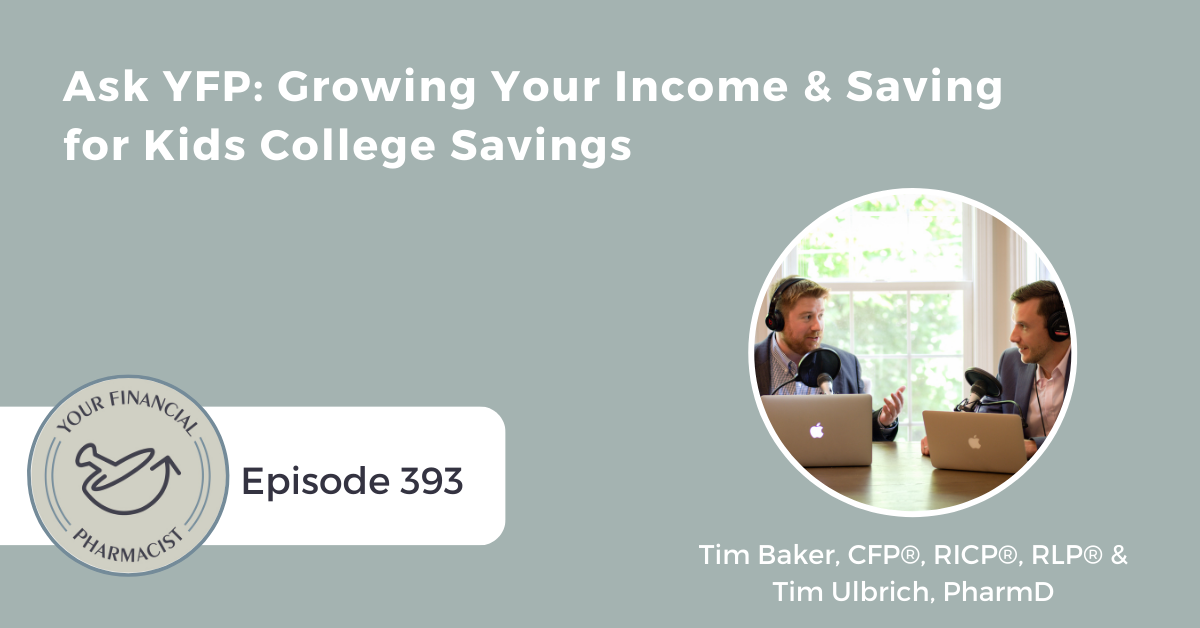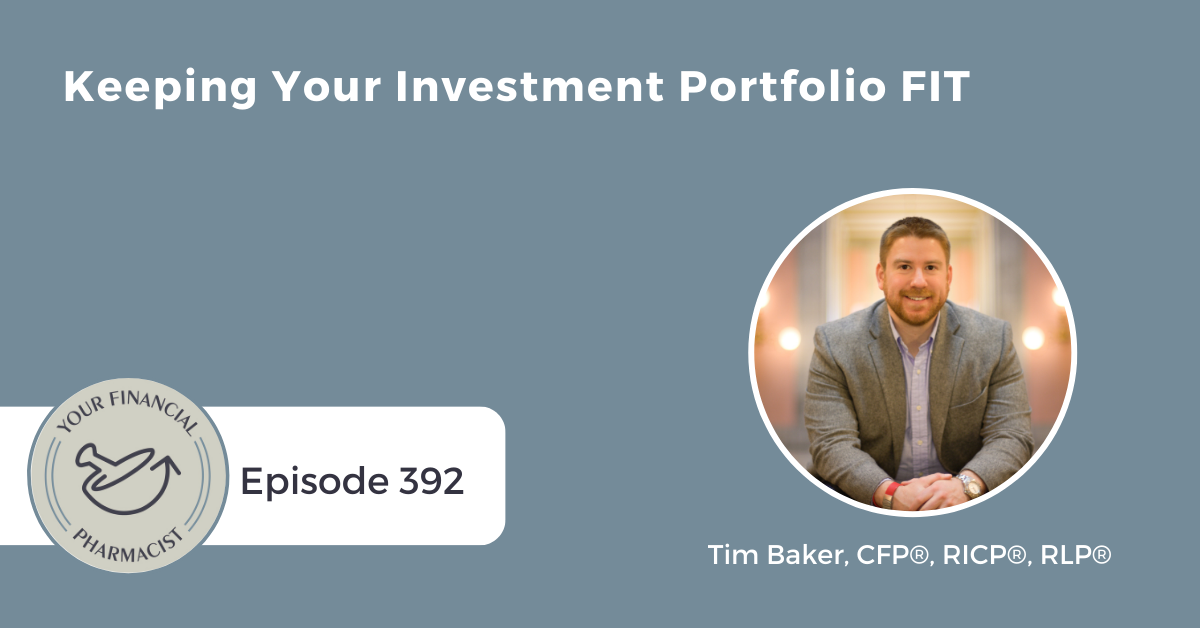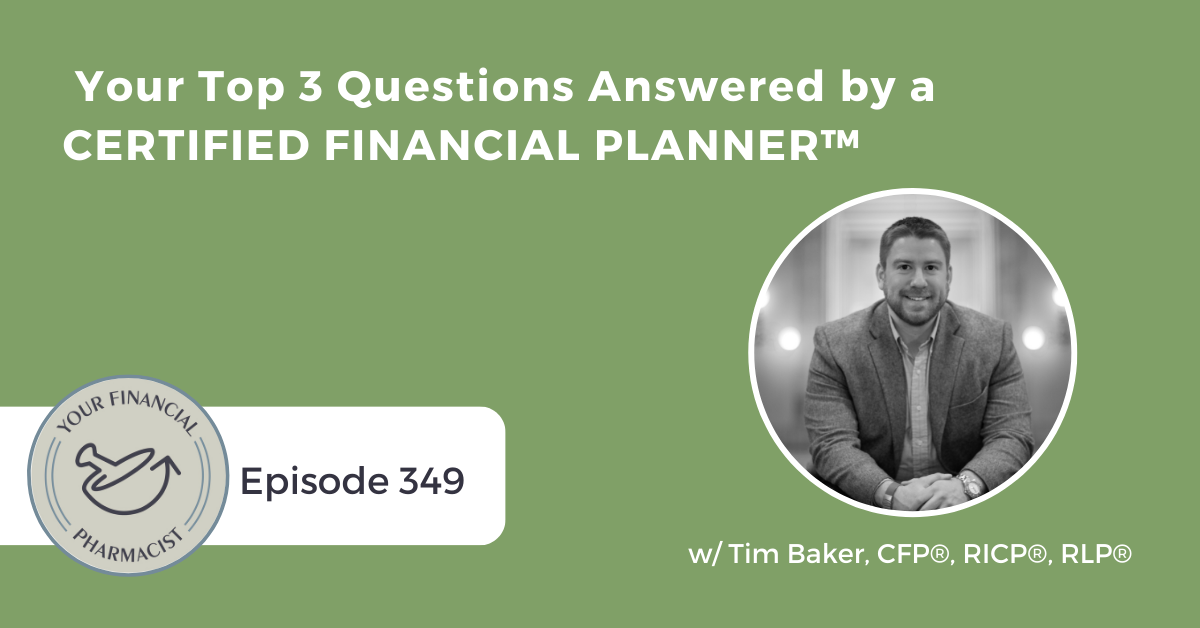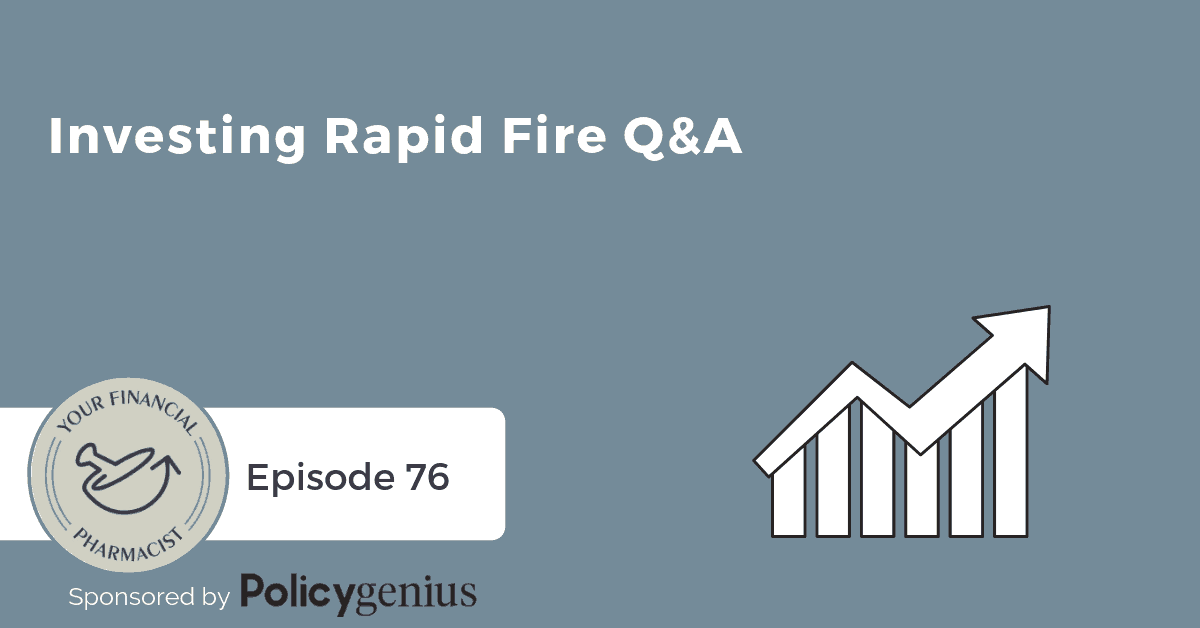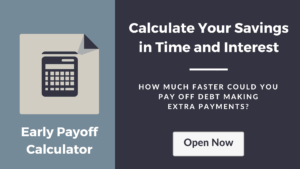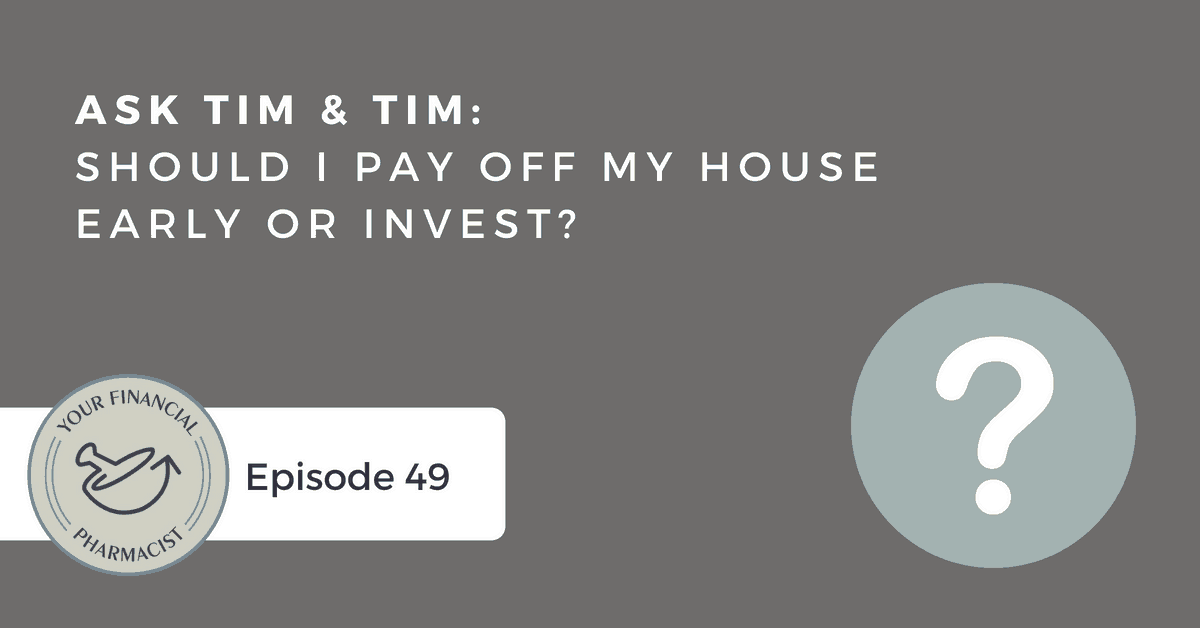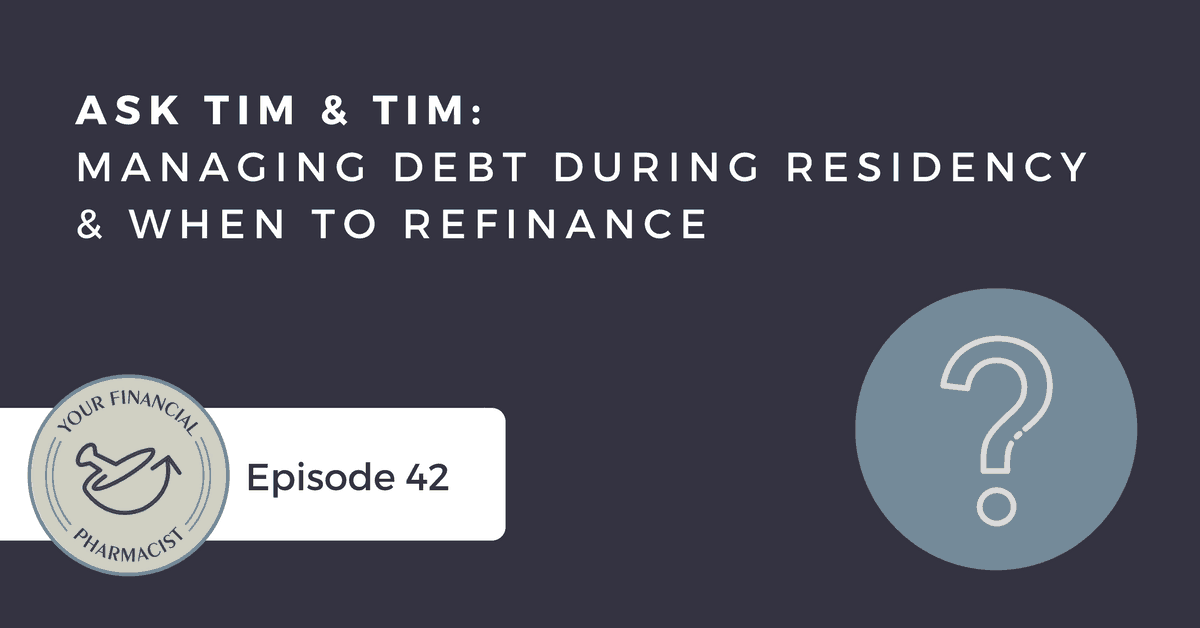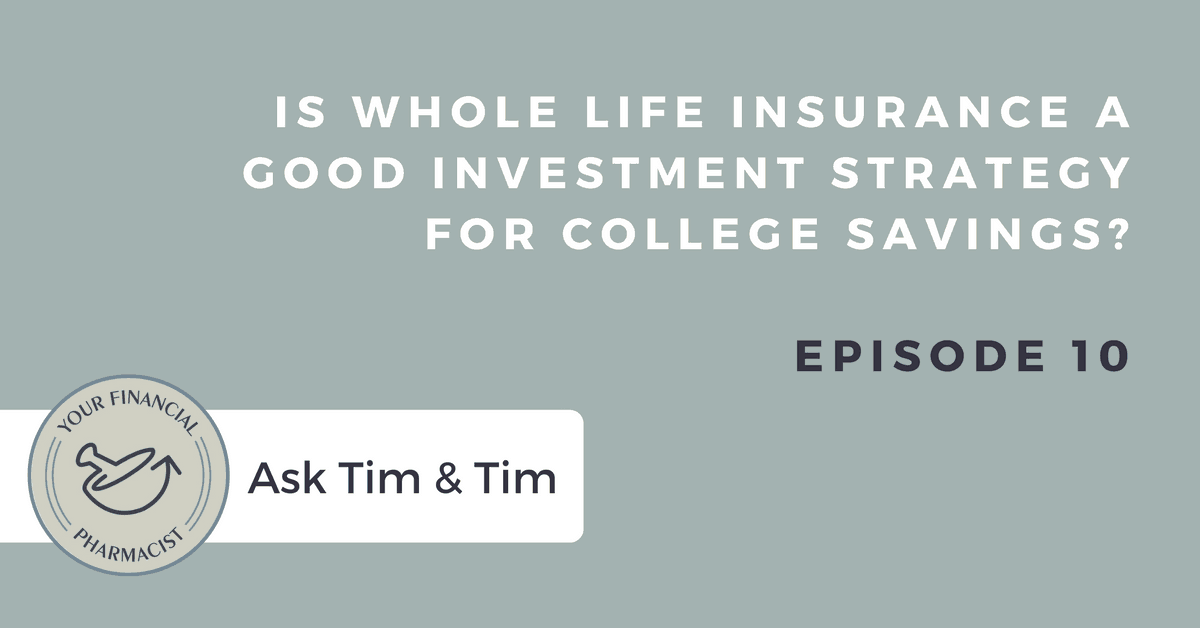Tim Baker, CFP®, and Tim Ulbrich, PharmD, share strategies to address fees, inflation, and taxes, helping you keep your investment portfolio fit and achieve your financial goals.
Episode Summary
In this episode, Tim Baker, CFP® and Tim Ulbrich, PharmD discuss a crucial topic related to personal finance: keeping your investment portfolio fit.
Tim and Tim explore three silent threats to your investments—fees, inflation, and taxes. Learn practical strategies to manage fund fees, mitigate inflation’s impact, and use tax-efficient approaches to safeguard your portfolio. Whether you’re starting to save or nearing retirement, this episode delivers valuable tips to protect and grow your wealth.
Key Points from the Episode
- [00:00] Introduction and New Year Greetings
- [00:12] The Importance of Keeping Your Investment Portfolio Fit
- [01:32] Understanding Investment Fees
- [02:08] Expense Ratios Explained
- [09:12] Other Types of Investment Fees
- [12:35] Advisor Fees and Their Impact
- [20:36] Inflation and Its Effects on Investments
- [26:19] Strategies for Pre-Retirees and Retirees
- [31:06] Taxes and Investment Income
- [36:37] Building a Retirement Paycheck
- [39:39] Conclusion and Final Thoughts
Episode Highlights
“ Step one is we got to save money. That that’s hard enough. But when we do that important step, we want to make sure that we can hold onto as much of the pie as we possibly can.” – Tim Baker [9:01]
“ And not all financial planning services are created equal. And so it’s not just a black and white discussion of what are the advisor fees, but what’s the construct and the makeup of the advising. And then those fees can look very different and whether they’re transparent and whether or not it has a return on investment with it.” – Tim Ulbrich [13:00]
“ I always tell the story of when I got into the industry and my parents were working with an advisor and I asked the question, “ Hey, what are you paying for that? The answer I got was like, oh, it’s free kind of through your dad’s work. And I’m like, uh, you know, there’s no free lunch.” -Tim Baker [13:55]
“ If you’re in a relationship and you’re not sure how the advisor is making their fee. That’s a big red flag.” -Tim Ulbrich [17:39]
“ The best number in terms of progress with the financial plan is your net worth, right? The assets, the things that you own minus the liabilities, things that you owe.” -Tim Baker [18:33]
“ The timing of when you retire is going to be one of the most important things. It’s related to your success in terms of having your assets not run out on you.”-Tim Baker [29:02]
Links Mentioned in Today’s Episode
Episode Transcript
Tim Ulbrich: Tim Baker, happy new year. Welcome back to the show.
Tim Baker: Yeah. Happy new year. Uh, can’t believe, uh, we’re on the other side of the new, uh, the new year already. The holidays, it’s, it’s pretty crazy.
Tim Ulbrich: We are, and we’ve got a topic that is connected to the theme of new year, but of course we’re going to bring it into first personal finance and that’s keeping your investment portfolio fit, fit, standing for fees, inflation, and taxes, really three things that are silent forces that can be working behind the scenes.
On the investment portfolio. You might not always see them directly, but their impact can really be big, especially over time. And Tim, that’s where you come in. That’s where our team of the only certified financial planners come in that have worked with pharmacists, clients all across the country to navigate this topic.
This is an area, right? That doesn’t really get [00:01:00] enough attention since I think it’s hard enough to focus on prioritizing saving. Let alone worrying about maintaining the integrity of those savings. Right.
Tim Baker: Yeah. And, and this, and this, if, if not paid attention to can be the, the drag right on your portfolio and your ability to build wealth over time. And, um, it’s important to, you know, especially, you know, when you’re evaluating your, your finances, which, you know, maybe a lot of us are doing at the start of the new year, um, to, to take a look at it and see, you know, Where we’re at with things.
So, um, yeah, it can be kind of one of those things that are behind the scenes, especially if you’re, if you’re struggling just to kind of get the portfolio and kind of the wealth building aspect of your, of your finances off the ground.
Tim Ulbrich: So Tim, let’s start with fees. We’ve all heard the saying, you get what you pay for, but sometimes in investing it might be the opposite, especially regarding fund fees. The may more you pay in fees, the less you actually keep in returns, potentially. We’ll, we’ll talk about that in more detail. And whether it’s from fund management fees to trading [00:02:00] commissions, there really can be many hidden costs that can add up, especially in the long term.
And it’s important that we understand what these fees are and whether or not they’re, they’re transparent, or we’re even aware of what they are. So walk us through the different types of fees that investors might encounter on their portfolios.
Tim Baker: Yeah, probably, probably the one of the most important ones, um, that, that we talk about is the expense ratio. So the expense ratio is essentially what a fund takes. Um, to manage said fund, right? So the way I explain this, Tim is, you know, let’s say I’m a, a fund manager and I’m managing billions of dollars of a large cap fund, right?
So my job is to, you know, gather information and, and really buy and sell stocks, large cap stocks inside of my funds that my investor has shares in. So for me to do that, I need. You know, a place of business. I need an [00:03:00] office space, which might be on, on wall street or thereabouts. I need analysts. I need to pay for information.
I need to, um, pay myself, pay salaries. So all of that work that’s done, you know, needs, you know, you know, revenue would essentially support that. So what the expense ratio is, is a percentage of the, the money that, that the fund manager is managing that they take out. Um, to basically pay themselves and all those things that I mentioned.
So the, the big, the hard part about this is that it’s not necessarily a line item on your, on your like, account statement. So, if you look at sometimes they’re listening to the account statement as, hey, you’re paying, you know, a half a percent, 0. 5 percent or 1 percent or, or, um, You know, 5 basis points, which is 0.
05%. So it might be listed as this is what the expense ratio is, but you can’t really draw a line from that [00:04:00] to, like, what’s actually being taken out of your account, which, which is hard. Right? So, and what we often see is that. You know, there’s a lot of people that just don’t pay attention to this at all.
Um, and if we take the example of a large cap, you know, one of the, one of the big things, which like a, which with a large cap is that, you know, you can buy a large cap where you’re paying. 0. 03, three basis points, or you’re paying way north of that 1%. And really the only thing that’s different is the fee itself.
When you actually like, you know, unwrap that fund and you look at the individual stocks that they’re in, it’s all the ones that we know, Microsoft and Amazon and things like that. So you’re kind of paying a premium for. I don’t know what a name potentially. So it’s really important when you’re looking at, when you’re selecting your investments, or if you’re working with an advisor and they’re helping you select investments that, you know, you are getting.
Bang for your buck. Right. So it, my, my thing is like, if I’m going to pay, you know, a hundred [00:05:00] basis points, you know, 1 percent versus five basis points. So that’s a 20 X difference in fee. For me, the way that I look at that, this is like, I should be getting 20 times more performance or 20 times safer. For the same amount of performance, but it’s typically not the case, right?
It’s typically not that. So, you know, I can say that, you know, where we, what we typically like to do is drive those fees, that expense ratio down as, as much as possible. And some of the other fees that we’ll talk about, um, and really let the portfolio do what, what it, what it does, what the market do, what it does.
So the expense ratio is a, is a huge, huge part of that.
Tim Ulbrich: Tim, when, when we hear, you know, five basis points or 0. 05 or three basis points, 0. 03 versus something like 1%, You know, I think we look at that with a little bit of shock and awe, but, you know, the average investor, if you’re not thinking about this, looking at these, if you don’t feel them right in your portfolio, necessarily, you know, it’s not impacting monthly cashflow per se.
You might look at those and say, [00:06:00] how, how much does that really matter? Right. So why, why does a type of difference when you look at something like five basis points or 0. 05 versus 1%, you know, over a long period of time, the question really is impact. What, what is the potential of that impact?
Tim Baker: Yeah. So, I mean, if you, if you take a, you know, for just simple math, if you take a, , 100, 000 portfolio, and you’re in a fund that is charging you 5 basis points,. That’s 50 per year for that. Um, if we stack that up, so let’s say I’m invested in the same type of large cap fund, but it’s charging me 1%.
That’s 1, 000. Per year. So like, you know, if we add zeros to this, we can kind of see where this is going. Right? So, so to me again, like, I don’t, you know, one of the, one of the positions that we, that we pay a little bit more and they’re newer, um, and more specialized is, is like the spot Bitcoin ETFs. Like, I think the, the fund that we’re in, it’s, it’s 20 basis point, but typically our, our portfolios are four or five basis points, [00:07:00] 0.
04, 0. 05. So what I tell the client, as I tell myself is like, if I’m paying more and I’m not getting that return, or it’s not safer.
It doesn’t make sense. So to me, it’s driving those down, you know, um, as much as possible. And you can see the numbers like, again, like if I look at 1%, I’m like, oh, it’s not really that much. But over time and over many years, it’s just, those are the, those are the things that erode, erode your gain and they don’t really need to be.
So, um, you know, and to back up, like if you buy an all stock portfolio, like you don’t buy a fund, you don’t have Expense ratio, because they’re not inside of a fund. You’re buying the individual stocks. The danger there is you’re potentially, you know, um, paying commission. So anytime you buy and sell you can, you, you are charged a fee and then just the, the risk that you take, you know, in terms of like, are you broadly diversified?
Are you putting too many eggs in, in one basket? So, you know, what, what I view as, you know, good investment practice is I can, I can build a well diversified Portfolio, um, for minimal cost and again, I would put minimal cost of anything less than, you know, in the 20 to, you know, 10 basis points, like, in that range, um, and feel good about, you know, the, the construction of the portfolio and the risk that I’m taking.
Um, so I, I do think that I, I’m willing to pay the toll, the expense ratio for that and not necessarily buy individual stocks and bonds and things like that.
Tim Ulbrich: So Tim, you mentioned expense ratios. Um, obviously that, that kind of becomes the top one that we think about, especially if they’re inside of a fund, you mentioned commissions, what, what other types of fees are out there that, that folks might, may not be as aware about?
Tim Baker: Yeah. So if you’re thinking about trading and transaction fees, um, you know, there, there are brokerage commission. So these are fees charged by a broker for executing trades on your behalf. So it could be something like a, a stock trade commission. Um, these are typically flat fee, so it could be anywhere from 5 to 10.
Um, a lot of these have kind of gone, there’s a lot of commission free brokers, um, that have kind of, you know, um, squashed a lot of these, but they’re still there. If you’re, if you’re option trade in, there’s option trade, uh, commission fees, there’s mutual fund, uh, transaction fees. So these can range anywhere.
You know, when I was in the broker deal world, I think it was almost like 30 per trade, right? Typically the range is, you know, 10 to 15. You know, 50 per trade. So, um, they’ll, they’ll, uh, they’ll, you know, brokerage will charge us, you know, to buy and sell, you know, mutual funds. There could be like spread costs.
So the difference, this is the difference between like the bid and the ask price of a particular trade. So they might, um, have a little bit of a spread. So they’re, so, so the, you know, the brokerage is making money. Um, one of the big things that I remember, especially being in the broker dealer world is account maintenance fees.
So these are, these are fees charged, uh, for maintaining an account. Um, such as an IRA. Um, and these, you see these more [00:10:00] Tim in like low interest rate environments. So they’re not making a whole lot of money on the float of the money that, you know, cash that they’re sitting on. So they try to find ways to make money.
Um, and these, these could be. I think when I saw them, it was like 50 an account. I see them anywhere from like 25 to a hundred dollars annually. Um, sometimes there’s foreign transaction fees. So these are applied to trades on international exchanges. There could be redemption fees. So these are fees for selling certain types of mutual funds or ETF within a specified, like holding period.
Um, so as an example, like if you, if you look at your account statement and you see, Like, uh, a mutual fund that you had that has an a, like next to it, that’s an a share mutual fund that you were probably, uh, sold that had like an upfront commission. Right. And, um, a lot of people don’t know that up going in, um, and they pay that and they’re like, what, what the heck happened?
There’s also C shares. [00:11:00] That you pay a little bit on the front end and then you pay an ongoing fee, um, which is not great. Those are typically the worst ones. And then you have a B1, which is kind of an in between that. There’s like a holding period that you can sometimes get redemption. So being, um, where we, we don’t, you know, we don’t operate in them, but I do come across a lot of clients that are like, oh, I’m not paying commissions.
And I look at their statement and there’s A’s and C’s. That’s what you typically see, excuse me, all over the place and they just don’t realize it. So. And probably the last one that I hear is kind of like robo advisor fees, right? I’m in a particular program and I’m paying, you know, a certain, certain amount.
So those are the ones that, you know, um, expense ratio, expense ratio, and then trading, trading fees, transaction fees, and kind of a slew of those that you’ll, you’ll often see.
Tim Ulbrich: Is that, is that it, that’s all you got on the list of, uh, potential fees that
Tim Baker: Yeah. And then we haven’t even gotten into the advisor fees, which we can talk about, but yeah. Yep.
Tim Ulbrich: let’s talk about that. Right. Because obviously, you know, that’s the work that we do and it [00:12:00] has to be factored in and, and full disclaimer, we’re, we’re biased in the value of the work that we bring clients. And we, we believe when you talk about advisor fees, Tim, when it’s done well, which is why we believe in the fee only model.
That’s why we have the model that we do that. Yeah, it’s a fee. Yeah. And it’s a fee that we have to factor in, but there’s a return on investment of that fee that we also have to account for. And not all financial planning services are created equal. And so it’s not just a black and white discussion of what are the advisor fees, but what’s the construct and the makeup of the advising.
And then those fees can look very different and whether they’re transparent so how do you think about the advisor fee piece?
Tim Baker: Yeah. And I, and I think, I think a big part of this is just like transparency, right? Like oftentimes, you know, when I would, I’d ask people that I’ve worked with an advisor, like, what are you paying them? They’re like, uh, I don’t know. Like, and I always tell the story, you know, of, you know, when, when, when I got into the industry and my parents were working with an advisor, you know, I asked the question, I’m like, Hey, what are you, what are you paying for that?
And it’s, you know, the answer I got was like, oh, it’s, it’s, it’s free kind of through your dad’s work. And I’m, I’m, And I’m like, uh, you know, there’s no free lunch. Right. So, and then years later, when I actually looked at it, you know, the fees were significant, like North of eight grand a year, right. Um, in the product.
So, you know, in the, in the broker dealer world, again, no shade to that, you know, where it’s more like fee based, so you can charge commissions, you can charge flat fee percentages. I think the problem is, is like. You know, what the advisor is trying to do is one help the client, but also make a living. So, so they’re, they’ll say, Hey, I can, I can get you in this investment and then I earn a commission.
Um, or I get you in this investment. I earn kind of an ongoing fee. And then maybe I sell you, you know, a life insurance product that I earn a commission or an annuity in our commission, or I charge you hourly. So it’s really just confusing. Right. So I think like. Transparency of fee and like, what you’re paying is really important.
And I think marrying that up to like the value that you’re receiving, right? So there’s some people that they view comprehensive financial planning as. Selling you an insurance product and managing your money. And that’s it. And then maybe talking to you once every couple of years, we don’t view that as comprehensive financial planning.
Like we, we view that as very light financial planning, if, if financial planning at all, maybe some investment management. So when you look at the different ways that advisors can charge, you know, fees, it could be a flat fee. It could be an AUM assets under management, which is a percentage of what they’re managing.
And it can be an. Assets under advisement, so it’s, you know, the feet, the investments that they’re managing directly at their own custodian, but also managing indirectly, say, at like, a 4 or 1 K or a 529. it could be commissions that we talked about, which could be commissions on insurance. It could be commissions on investment, which is kind of what we’re talking about here.
An hourly fee or kind of a combination of all these things. So, you know, I think I think the, the, the, the hard part for the consumer for the client is to determine a, like, what the heck are they paying? And are they getting value for that? Um, and if they’re not, then obviously, you know, reassessing it. So, you know, and there’s.
There’s pros and cons for all of these, right? Um, and there’s, there is no such thing as, um, you know, sometimes advisors, especially in the feeling where we’ll say, you know, we have, you know, we give conflict free advice that does not exist. It doesn’t in any model, there’s always a conflict of interest. And I think, you know, the advisors that that is willing to say, like, Hey, we think this is in your best interest.
However, cards on the table, it’s also going to change our fee, increase our fee. Um, and that can go the other way too. It’s also going to decrease our fee. Um, you know, I think those are the type of advisors that are my people, you know, we want what’s best for the, for the, for the client, but understanding, you know, what model you’re in and then like what you’re actually paying is going to be half the battle.
And, and, and more often than not, when I talk to prospective clients and I ask them, Hey, what are they, what are they, what are you paying? They’re like, I literally have no idea. And I think that’s problematic.
Tim Ulbrich: Yeah. And that’s what my experience tells me, Tim, is that, you know, especially the pharmacist households that we’ve worked with, even those that decided, Hey, we’re not, we’re not a good fit. Um, and that’s okay as well is transparency is what matters, right? They want to know what’s involved.
Everyone has a different definition of what, what is return on investment. What’s value that can change in different seasons of life. So, um, I think the transparency pieces is so critical. And if you’re in a relationship and you’re not sure how the advisor is making their fee. That’s a big red flag. Right.
And I think something worth exploring further.
Tim Baker: Yeah, and I think, you know, um, you know, when we talk about fees, like, you know, you’re no model is going to fit everybody. Right? So I think like, it’s just again, being comfortable understanding what you’re paying. Um, and, and, and what I was going to say was, you know, oftentimes, especially with pharmacists, type a scientific minds, they’re like, okay, if I’m going to give you, you know, X amount of dollars in fees.
What is the ROI? And I’m like, well, define ROI because the way that we look at this, the way that we look at ROI is that you, there is a quantifiable that you can count ROI, but I don’t even think it has anything to do with investment returns. I really think the best number in terms of progress with the financial plan is your net worth, right?
The assets, the things that you own minus the liabilities, things that you owe. But I think the other unspoken thing here is the, not the quantifiable things, but the qualifying things of, of what, what have we done with your plan with, with your life plan supported by the financial plan?
That’s hard to count. Whether it’s that, that family, that. Finally, you could buy the house when they didn’t think they could or had the baby or retired early or pivoted careers or got back into a passion that they had put on the sideline for a long time because of whatever reasons. Those are the things that get me fired up.
They have nothing to do with. Ones and zeros in the bank account or net worth or things like that. And I think if you’re in that type of relationship and you have that type of trust and rapport, that’s worth a lot. Um, so that’s my soapbox, Tim.
Tim Ulbrich: I agree. And, and I, you know, would be remiss if I didn’t put a plug in here for what we do and, and for those folks listening that would like to learn more about our fee only financial planning services, what our team of certified financial planners can offer, um, you Working with households all across the country, uh, virtually, you can learn more, your financial pharmacist.com. You’ll see an option at the top, right? You book a free discovery call to learn about those services. Tim, let’s shift to inflation. Um, so in addition to fees, we have to pay attention to inflation and this one feels a little bit sneaky, right? I mean, you’re making money, but inflation is quietly chipping away at your purchasing power.
Yes. Today. At the grocery store, I think we’ve all felt that recently and and perhaps five six years ago It was hey inflation what but we all have felt that more recently But not only in our expenses today might we feel that but also in the future When we think about how far our savings will go so explain to us how inflation erodes the purchasing power Of an investor’s returns over time
Tim Baker: Yeah. So when I talk about like, cause there’s a lot of people out there. That are super risk adverse. Right. So they’re like, Tim, do I really have to invest? Can I just like stuff my mattress or put money in my bank account, my high yields. And I call it a day. And the answer is like, especially if we’re aspiring to be a seven figure pharmacist, plug the book, um, answers.
No, you can’t. And the, when I talk about this, you know, um, with, with, in, in, in, in different talks, like when I look at inflation, if we take, If we take a latte that you buy at Starbucks in 2025, and let’s say it costs 4 dollars. Um, and maybe that’s just a plain coffee these days. But if you, if you, if you get that, that coffee at 4 dollars, if we use historical rates of inflation, and most advisors will use about 3%.
Now, you know, we’ve had years and spikes that, you know, some people are like, well, let’s use 3 and a half or 4%. But if we use 3 percent and we fast forward 30 years, from 2025 to 2055. That same latte that would cost 4. 00. Costs 10 30 years from now. So what that means is that your dollar just goes less far.
And this is why my dad’s in the 70s. You’d always talk about, you know, his grandparents would give him a nickel and you go to the candy store and buy half the store. It seemed right. You can’t buy anything for a nickel today, right? So the, the idea of investing and having a solid investment plan is to keep pace with the inflation monster, but then also get ahead of the tax man, which is what we’re going to talk about next.
So unfortunately we can’t bury our hands, head in the sand or, you know, and I, and I say that, Facetiously and just put money into a check into our savings account and call it a day because over time that, you know, 400, 000, you know, if we, if we look at it from an investment is going to be equivalent to 1, 000, 000 or the purchasing power of 1, 000, 000 in the future.
So. That’s why we need to invest and take appropriate risk and equities and bonds. And I would argue equities, you know, mostly through, you know, the working years of most people, or especially early on. And then as we get closer, you know, start to to add more bonds and fixed income. But that’s really what it is because, you know, every year, you know, the price of goods and services.
Goes up. Um, and it’s a systemic thing that we can’t escape. Um, you know, that we really have to adapt our financial plans to.
Tim Ulbrich: Yeah. And I think Tim, it can be easy to lose sight of historical trends when we’re in
Tim Baker: Yeah, for sure.
Tim Ulbrich: time periods. Right. So, you know, I’m thinking of this moment while we’re recording, although rates have come down, high yield savings accounts are. 4 percent ish, right. Give or take, um, we’ve had historically high inflation, you know, the last couple, a couple of years for obvious reasons we’ve talked about on the show.
And so I think sometimes people look at that and they say, oh, well, you know, 4%, that’s really good historical rate of inflation, but we can’t confuse those. Right. Because just a few years ago, what was our high yield savings account earning less than 2%? Well, I mean, for a while right down there, I mean, even lower than that.
So when we zoom out. Yeah, we get, get those emails, right? Your, your savings account has gone down, but you know, if we zoom out, we look at the historical rate of inflation. If we’re not investing and it taking some level of calculated risk and what that risk tolerance and capacity is, is different for, for everyone.
And that has to be customized, but if we’re not doing that, right. Our, our long term investments really come to be at risk and in terms of us achieving our long term goals.
Tim Baker: Yeah. And I’ll give you an example. So if we talk about the long term effects of inflation, so, um, over time, inflation compounds, meaning it’s cumulative effect on person power grows significantly. So, like, if we take 100, 000 portfolio and we invested at, um, we get a 6 percent annual return over 20 years.
Without inflation, that portfolio grows to from 100, 000 we’ll call it if we, if we then interject reality, which is about a 3 percent inflation, the real value of that investment, if we adjust for inflation would be 180, 000. So that’s, that’s the, that’s the rub here. And again, that’s, that’s why, you know, when people are like, Oh, I’m like really conservative.
I don’t want to take risk. I’m like, you kind of have to get in front of this, you know, especially in, you know, younger in your younger years, um, you know, to get in front of again, inflation and then, and then the tax man.
Tim Ulbrich: Yeah. And this is also why, when we’re doing things like retirement projections, nest egg calculations, especially for people that are maybe in that, you know, front half of their career, let’s say they look at these numbers and they’re like, is this wonky math, right? These seem like they’re huge. They’re out of reach.
Well, we’re, we’re thinking about it in today’s dollars. And obviously we have to be thinking about it. In the future as well, Tim, you alluded to retirement age a little bit. When you’re talking about asset allocation, let’s just touch on that a little bit more. So for maybe some of the pre retirees listening or people that are in the second half of their career that are thinking about retirement, it’s on, on the horizon and are concerned about the long term effects of inflation on their portfolios, ability to generate income and to sustain itself.
What are some general strategies that we’re, we’re thinking about employing? I know you’ve talked before on the show about, Hey, social security, right? It’s, it’s one of those rare vehicles that we have some inflation protection. What, what, what [00:25:00] other thoughts here?
Tim Baker: Yeah. I think as you look at your, your investment strategy, like there are things that, yeah, you mentioned. So that’s why we’re a big, you know, a big believer and really having a very purpose based strategy when it comes to a, uh, social security claim. And because once you made that decision, it’s kind of forever.
And that can really affect the amount of. Inflation protected income that you have coming in the door. Um, so the other things you can think about is there are inflate, there are inflation protected security. So there’s tips treasury inflation, protective securities that are linked, um, to they’re kind of marked to inflation.
So as you know, as, um, Inflation goes up. So does the interest payments for which you, you know, which you receive, um, they don’t necessarily, they’re not necessarily, you know, growth oriented, but it helps you kind of, you know, at least keep pace with that. What we’ve been talking about, you know, at length here is, is really having a portfolio that’s invested in growth oriented assets.
So stocks. Real estate could be commodity commodities that outpace inflation over time that kind of provides a hedge against inflation reinvest in your return. So compound and helps offset offset the negative effects of inflation over time. Another thing that, again, we believe in, um, that not everyone does, but even diversify internationally.
So invested in global markets may reduce inflation. Um, Risk retired, you know, tied to kind of the U. S. Dollar or the economy. And then probably the big thing I hear, or I see, and I actually just had a conversation with perspective client, you know, they were sitting on over 200, 000 of cash and I’m like, why?
And part of its monitor cash holdings. So cash lose unless it’s in a high yield. It’s kind of getting close to that. You know, and today 4 percent cash loses purchase and power quickly in inflationary environments. So you want to really limit the cash that you have idle. So we kind of talk about, you know, you want your emergency fund and any short and medium term goals that you need cash for.
So that might be a trip might be a project on your house, et cetera, et cetera. And that foundation is set to then get money into the market for more, you know, longer, longer term type plan. And so those would be things, you know, like, like I mentioned, you know, it could be, you know, what you invest in, whether it’s tips, you know, growth, equity type of, of stocks could be commodities, but then also some of the things that you’re doing, you know, with cash and, and how you reinvest returns and things like that can help Kind of tackle, tackle the, the, the problem, you know, the, that won’t ever go away, which is the inflation, um, associated with your, with your assets.
Tim Ulbrich: Yeah. One last thing I would add in here, Tim, and this is where I think the flexibility piece is so important. And we’ve, we’ve talked at length on previous shows about this, but if someone has some flexibility. With their retirement situation, whether that be part time work, whether that be the [00:28:00] timeline of when they retire, and we’re in a high inflationary period or a downturn in the market, right?
Things that we may not anticipate happening. Those types of levers that we can pull go a long way in terms of how we maintain the integrity of our, our investment pie as we go throughout retirement, so it’s not a set it and forget it so important when we think, you know, I think back to my early years of saving.
You know, coming out of pharmacy school and it’s like, all right, we’re going to pay it away, whatever, 20, 25 percent of our income. And we’ll kind of think about this tomorrow and that that’s good early on. But then you get to this point in time where we start to ask this question. I’ll be like, Hey, are we on track?
And you know, what is the horizon timeline? And then more nuanced questions, like some of the tax strategies, when we think about withdrawals or, Hey. You know, the markets had an unexpected downturn or we’re, we’re in a down market for a longer period of time. And maybe it’s not the best time to retire, or maybe I could retire early.
Right. There’s all these wrinkles that we have to consider as we get closer to that timeline.
Tim Baker: [00:29:00] yeah. And, and, you know, probably the timing of when you retire is going to be one of the most important things that, you know, um, You know, it’s related to your success in terms of having your assets not run out on you.
Tim Ulbrich: All right. The last piece of our, uh, keeping your investment portfolio fit fees, inflation, taxes, taxes is number three, certainly last, but not least. This is a big one, right? They could take a huge chunk out of your investment Income, particularly if you’re not strategic about it. We’ve harped on that on the show many times before about being proactive with your tax planning and how important that is to the financial plan and whether it’s not maximizing tax advantage accounts, whether it’s realizing, you know, capital gains, taxes, when you’re selling investments or taxes on interest income, if you’re not paying attention to taxes, Tim, it can really hurt your returns.
And, and I think tax is just one of those dry topics that, Hey, we’d rather not really think about.
Tim Baker: Yeah. And it’s, it’s another one, it’s another one that has major [00:30:00] implications on, you know, again, your, your ability to, um, grow your wealth and, and, and keep pace with, with lifestyle, especially in retirement and, and, and really throughout your, your, your whole life. So, you know, I, I think, I think one of the big things that I think about, so when I, when I talk about taxes and investment, I kind of lead with a little bit of a depressing, like example.
So like, if we look at a million dollars and a traditional 401k, a million dollars in a Roth IRA, a million dollars in an HSA, et cetera, then one of the questions I always ask is like, how much money do we actually have? And. Unfortunately, we don’t have 3 million or 4 million dollars, how many bucks it is because anything that is gone into a pre tax bucket, like a traditional IRA, a rollover IRA, a traditional 401k uncle Sam has yet to take his bite of the apple.
Right? [00:31:00] So the mechanics of this is like, if I put money into my 401k, let’s say I put 20 grand in, um, I make 100, 000 a year. The IRS looks at me is if I made 80, 000. So I get a deduction for that. So that 20, 000 goes into my, my 401k. It grows tax free, which is great, which means I’m escaping capital gains. I don’t have to pay capital gains.
And then when I pour that money out in retirement, that’s when it gets taxed. Right. So if I have, you know, over time, I have a million dollars there and I’m in a 25 percent tax bracket, actually 750, 000 of that is mine. And 250, 000 of that is the government. So I think what’s really important about taxes and investment is actually something called, um, asset location.
So these are different types of investment accounts that have different, uh, tax treatments. And the, and the three main buckets here, Tim, are the. Uh, The tax deferred accounts, which I just talked about. So this is kind of a traditional 401k traditional IRA. [00:32:00] So these contributions are pre tax and the investment gross tax referred and then the withdrawals are typically taxed at ordinary income levels.
We have the tax free accounts, which is a little bit misleading because you actually pay the taxes, you know, as it goes in. Um, so these are things like Roth IRA, um, Roth 401k. So the contributions are after tax. So I’ve got my paycheck. I’ve already been taxed and I put those money into a Roth. That investment grows tax free and the withdrawals are then tax free.
So when I pour out that money, so if I have a million dollars in a Roth IRA, I pour out all million dollars of that. I actually get all million, all 1 million of that. And then the last one is the. Taxable accounts. These are the brokerage accounts. So these are taxes, taxes are paid annually on interest, dividends, capital gains, typically the contributions are with after tax dollars.
So I was, I was taxed on it, um, through my paycheck. I contribute that to a taxable account. It grows, but then any capital gains, um, interest dividends, [00:33:00] I’m, I’m taxed again. Um, and that’s where we get into things like tax loss harvest. So, you know, depending on where you’re at. geographically where you’re at in life, you want to have a little bit in column a, a little bit in column B, a little bit in column C, right?
So it’s really important to be able to when we’re building, if we fast forward to retirement and we’re building a paycheck, if I’m the maestro and I’m building a retirement paycheck, I know that Maybe we’re getting in some in from consulting part time work team. Maybe we’re getting some in from, um, social security, which is also taxed, but then the gap that I’m trying to make up between those things and what we need to, you know, live in and thrive.
I’m pulling from these 3 buckets and, you know, if I have a balance of those 3 buckets, it benefits me because what I’m trying to do as a planner is fill up your tax bracket in the most efficient way [00:34:00] possible. So I might take some from the pre tax bucket to get you to, you know, to max out that 12% Um, tax bracket.
And then maybe I go to the, um, the, the Roth to then, you know, get the rest. Maybe we’re, we’re retiring at 58. So then I’m, I’m using primarily, um, a brokerage account because anything between before 59 and a half, you know, I get a penalty and pay taxes. So, excuse me, that’s the, the asset location is really important to determine how we then pull it in retirement and what makes the most Efficiency wise, um, from a tax perspective.
Tim Ulbrich: Yeah. And what you’re talking about, Tim is building a retirement paycheck, right? We talked about this on episode 275. We’ll, we’ll link to that in the show notes, but I love that visual. Cause we all, we all can relate to that, right? Throughout our career, whether we work for someone else, we’re self employed, you know, we have some semblance of a, of a paycheck, maybe it’s fixed, maybe it’s variable, you know, for time, but eventually we’re going to get to [00:35:00] this future state where maybe we’re working part time or eventually we’re not working at all, Or we have to produce our own paycheck.
And there’s going to be multiple sources that are feeding into that. You mentioned it could be social security. It could be, uh, an annuity. It could be, uh, coming from an IRA. It could be coming from real estate. It could be coming from a 401k, right? All these different pathways. And it highlights so well, the point that not all buckets and dollars are created equal as you articulated.
So, well, you could have two people that both have 4 million. And where that 4 million is going to go and how it’s going to be deployed could be very different depending on what buckets from a tax standpoint. And it’s important on the front end. So we’re talking withdrawal side with the building and the retirement paycheck, but it’s also important on the front end is we’re saving, not that we can predict everything that will happen in the future.
But if someone says, Hey, Tim, I want to retire early. And they’re serious about that. Well, we got to think about where those buckets of dollars are going to be and how do we build a plan and a way to support that? So, you know, this is where [00:36:00] online nested calculators fall short, right? Just, just punching in numbers and saying, Hey, Tim, you need 3.
4 million saved, like where, how, what’s that going to look like? What are the tax treatments? All those questions have to be answered.
Tim Baker: Yeah. And it’s, it’s so nuanced, right? Even like, we talk about our own situations. Like, we’re two Tim’s in Ohio. Our financial situation is similar, but different. But even, even with slight variation, we just, there’s, there’s certain things that we, that, that I’m doing in my plan that you’re not doing and vice versa.
Right? Like, one of the, one of the cool things about being self employed in Ohio is, you know, your first 250, 000 per year, there is no state income tax. Um, So, you know, when I moved from Maryland, I’m like, Oh, like I need to really take advantage of that. And hit my Roth harder than what I was, because I’d rather pay the tax.
Now, I just pay federal, um, and, you know, use another example. Like, if I decide [00:37:00] to retire in Florida, you know, maybe I don’t I don’t need to do that, you know, but I’m not retired. I’m not planning on doing that. But, you know, if you’re, if you’re working in a state with income tax and retirement with a state that doesn’t, again, there’s legislative risk there because, you know, things could change, but all of those things kind of play a part in this.
Journey, which is what it is. Um, and it, it’s hard to get that from a calculator and, you know, it is nuanced. And I think, um, you know, provide, you know, it requires a level of care and attention, um, especially when we’re talking about the, the nest eggs and, and the assets that were, you know, that we’re working with over time that, you know, just requires some level of love and attention, really.
Tim Ulbrich: Tim, great stuff. We covered a lot in a short period of time, fees, inflation, taxes, three really important parts as we think about our investment portfolio. And we really are just scratching the surface on all of those areas. We’ll link to some of the episodes. We’ve got more information in the show notes.
Thank you so much everyone for listening to this episode of the podcast. If you’d like [00:38:00] what you heard, do us a favor, leave us a rating and review on Apple podcasts. Or if you’re watching on YouTube, would you help other pharmacists find our show as well? And finally, an important reminder that the content in the show is provided for informational purposes only is not intended to provide and should not be relied on for investment or any other advice, information on the podcast and corresponding materials should not be construed as a solicitation or offered by ourselves, any investment or related financial products for more information on this, you can visit yourfinancialpharmacist.com forward slash disclaimer. Thanks so much for listening. Have a great rest of your week.
[END]
Current Student Loan Refinance Offers
Advertising Disclosure
| | | | YFP Gives accepts advertising compensation from companies that appear on this site, which impacts the location and order in which brands (and/or their products) are presented, and also impacts the score that is assigned to it. Company lists on this page DO NOT imply endorsement. We do not feature all providers on the market. |
| Loans ≥150K = $750* ≥50K-150k = $300 |
Fixed: 4.89%+ APR (with autopay) | A marketplace that compares multiple lenders that are credit unions and local banks | |
| | Variable: 4.99%+ (with autopay)* Fixed: 4.96%+ (with autopay)** Read rates and terms at SplashFinancial.com | Splash is a marketplace with loans available from an exclusive network of credit unions and banks as well as U-Fi, Laurenl Road, and PenFed | |
Recent Posts
[pt_view id=”f651872qnv”]




